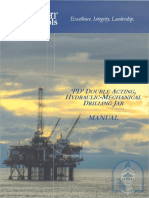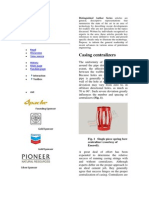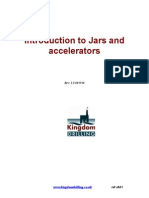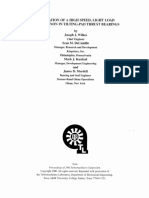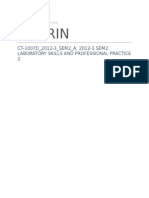Mud Motor
Mud Motor
Uploaded by
Rohit ViegasCopyright:
Available Formats
Mud Motor
Mud Motor
Uploaded by
Rohit ViegasCopyright
Available Formats
Share this document
Did you find this document useful?
Is this content inappropriate?
Copyright:
Available Formats
Mud Motor
Mud Motor
Uploaded by
Rohit ViegasCopyright:
Available Formats
Motor Handbook Jaguar Downhole Tools
The LEADER in Performance
Drilling Motors
MOTOR HANDBOOK
Rev. A, 2007
The information in this handbook is intended
solely to provide basic operational data and
reference information to the operator.
Jaguar Downhole Tools, Inc.
3031 N. Frazier Conroe, TX 77303
936.441.4366 phone
Motor Handbook Jaguar Downhole Tools
TABLE OF CONTENTS
1. Introduction
a. Background
b. Quality Control
2. Motor Description
a. Top Sub
b. Rotor Catch
c. Power Section
d. CV Assembly
e. Bearing Assembly
3. Motor Operations
a. Start Up Operations
i. Curve Interpretations
ii. Torque Calculation
b. Operational Considerations
i. Stalling
ii. Rotary Drilling
iii. Tripping
iv. Reaming
v. Downhole Temperature
vi. Lost Circulation Material
vii. Oil-Based Mud
viii. Solids/Sand Content
ix. Catch Mandrel Ops.
x. Rig Site Evaluation
4. Motor Specifications
5. Glossary
Motor Handbook Jaguar Downhole Tools
Section One 1-1 Introduction
BACKGROUND
Jaguar Downhole Tools, (JDHT) was established in 2003,
with the purpose of supplying the oil & gas industry with a
series of high performance and highly dependable built-for-
purpose performance drilling motors.
Operators have recognized the advantages of downhole
motors for vertical drilling applications.
• Increased rate of penetration.
• Better hole deviation control.
• Reduction in drill string failure rate.
• Reduction in casing and drill pipe wear.
• Reduction in wear and tear of the swivel, Kelly, and
rotary drives.
• Reduction in fuel cost, since compared to rotary
drilling, less energy is required to power a Downhole
motor.
In short, Downhole motors can reduce the overall drilling costs
and increase drilling efficiency.
Jaguar’s built-for-purpose straight hole drilling motor was
designed to accommodate the demands of performance drilling
operations. The motors provide the operator with more power,
strength, and reliability over conventional motors. Jaguar has
proven to be a major player in the onshore markets of the Gulf
Coast, Permian Basin, and Rocky Mountains, with Field and
Client records in each area.
Motor Handbook Jaguar Downhole Tools
Section One 1-2 Introduction
QUALITY CONTROL
Our dedication to quality has been one of the main factors in the
success of our motors. Each aspect of our quality control helps to
ensure we provide a quality product to our clients.
• COMPONENT TRACEABILITY – all major
components of the motors are serialized and their status
closely tracked throughout their useful life.
• MP INSPECTION – after each field run, every motor is
completely disassembled, prepped, and inspected using
the wet Magnetic Particle inspection method. All
internal / external connections and internal drive
components are inspected for cracking and connection
damage.
• VISUAL / DIMENSIONAL INPSECTION – Once
subjected to the magnetic-particle inspection, each
component then undergoes a visual and dimensional
inspection to determine component reuse.
• SERVICE – Our experienced staff is available around-
the-clock to answer your questions and assist you with
your motor needs. We are certainly interested in hearing
from you with your comments and recommendations
regarding our products and services
Motor Handbook Jaguar Downhole Tools
MOTOR
DESCRIPTION
Motor Handbook Jaguar Downhole Tools
Section Two 2-1 Motor Description
MOTOR DESCRIPTION
This section of the handbook is designed to provide the operators
with a general description of the Jaguar mud motor.
Although motors differ in size and performance characteristics,
they share the same basic components.
• Top Sub
• Power Section
• Transmission Assembly
• Bearing Pack Assembly
Motor Handbook Jaguar Downhole Tools
Section Two 2-2 Motor Description
TOP SUB – Jaguar’s top sub provides three functions. Its primary
use, serves as a crossover between the motor assembly and the
drill string. It also allows for placement of a float valve, and
includes part of the rotor catch system.
Rotor Catch Assembly – This is a safety feature that is
incorporated into the design of all JDHT motors. It serves as a
retaining device in the event of an external connection failure in
the motor.
The rotor catch offers the operator the ability to retrieve the
broken motor assembly. Additionally, the rotor catch offers
limited circulation capacity to operator while retrieving the motor.
Figure: Rotor Catch Engaged
Motor Handbook Jaguar Downhole Tools
Section Two 2-3 Motor Description
POWER SECTION – As with most Downhole drilling motors,
Jaguar utilizes a rotor and stator based on the Moineau principle.
The Stator is a steel tube lined with a profiled elastomer. The
rotor is a steel shaft with a helical profile, which runs inside the
stator.
Drilling fluid is pumped downhole through the drill pipe at a given
rate and pressure. Once the hydraulic energy of the drilling fluid
reaches the motor, that fluid moving through the power section is
converted into rotation and torque. This mechanical energy is
transferred through the rest of the motor directly to the drill bit.
The power section has many different configurations available.
These configurations vary on basis of torque and rpm
requirements, as well as downhole conditions such as temperature
and drilling fluids used.
TRANSMISSION ASSEMBLY – The Flexible Coupling is the
link between the rotor and the
Bearing Mandrel. This assembly is
required to distribute the eccentric
and rotary motion of the power
section to the drill bit.
Motor Handbook Jaguar Downhole Tools
Section Two 2-4 Motor Description
BEARING PACK ASSEMBLY- The Bearing Pack Assembly is
designed to accommodate the thrust and radial loading applied to
the motor during operation.
The thrust loads can come from various sources, such as weight
applied to the motor, hydraulic pressure drops across the drill bit
and/or power section, and back-reaming operations.
The Radial Bearings rigidly support the bearing mandrel inside
the bearing housing. They are designed to withstand the radial
forces generated during drilling, while maintaining the bearing
mandrel alignment and concentricity.
Additionally, the radial bearings govern the fluid flow that helps
lubricate the thrust bearings. This bypass rate is controlled to a
maximum of 15%.
The Thrust Bearings are designed to sustain the applied weight to
the drill bit while on-bottom. They are also capable of bearing the
downward hydraulic thrust load of the rotor while circulating off-
bottom or drilling with underbalanced bit weight. A belleville
spring is utilized to dampen any shock loading that may occur
while the motor is drilling.
Figure: Thrust Bearing assembly with Belleville spring
Motor Handbook Jaguar Downhole Tools
MOTOR
OPERATIONS
Motor Handbook Jaguar Downhole Tools
Section Three 3-1 Motor Operations
START UP OPERATIONS
Once the motor has reached just slightly off bottom; increase
circulation to desired flow rate. Note the off-bottom standpipe
pressure. This information will be required later to achieve
optimum performance of the motor.
Slowly lower the motor to the bottom off the hole. Increase the
weight on bit (WOB) in 2000-3000 pound increments for 1’-3’.
This will help establish a bottom hole pattern for the bit. Once the
bit has become seated, apply WOB and increase rotary speeds to
the recommended parameters of the bit/motor. At this point, there
will be an increase in standpipe pressure, once the motor has
begun to drill ahead.
Motors are hydraulic based tools operating specifically off of fluid
flow and pressure ratings. In order to effectively operate the
Jaguar Mud Motor, flow rate and differential pressures must be
known.
The ON-bottom pressure can be subtracted from the OFF-bottom
pressure to obtain the differential pressure of the motor.
EXAMPLE
On-Bottom P.S.I. - Off-Bottom P.S.I = Differential PSI
2850 P.S.I. - 2200 P.S.I. = 650 P.S.I. diff.
Motor Handbook Jaguar Downhole Tools
Section Three 3-2 Motor Operations
CURVE INTERPRETATIONS
Given that motor performance is dependent on flow rates and
pressure. The following examples break down the flow curves to
approximate downhole motor performance.
RPM Calculation
With the flow rate and differential pressure, the curve will
determine both the motor RPM and Torque Output. To determine
bit speed, the bottom and left axis are used.
FLOW RATE: 500GPM
DIFFERENTIAL P.S.I.: 650 P.S.I.
APPROXIMATE RPM: 125 RPM
The motor will decrease in RPM as flow rates and differential
pressures increase. This is due to inherent design inefficiencies of
the progressing cavity pump. At full load, the inefficiency of a
mud motor is approximately 15%. The main loss in RPM is
caused by slippage in the sealing cavities of the power section.
Motor Handbook Jaguar Downhole Tools
Section Three 3-3 Motor Operations
Speed Ratio Calculation
To determine the speed ratio of a power section, revolutions per
gallon, use the following formula below.
Maximum speed (at zero p.s.i.) / Maximum Flow Rate = rev/gal
160 r.p.m. / 600 g.p.m. = 0.26 rev/gal
TORQUE Calculation
To determine torque output at the bit, use the right axis of the
curve along with the differential pressure axis.
FLOW RATE: 500GPM
DIFFERENTIAL P.S.I.: 650 P.S.I.
APPROXIMATE TORQUE: 6000 Ft-Lbs.
Each power section design has an individual torque slope. The
torque slope is a factor of ft-lbs./P.S.I. The given torque curve
provided with the motor takes into account the inefficiencies
discussed earlier.
Motor Handbook Jaguar Downhole Tools
Section Three 3-4 Motor Operations
OPERATIONAL CONSIDERATIONS
STALLING
When the operating parameters exceed the capability of the motor
and/or bit, a stalling condition can occur. A sudden severe increase
in standpipe pressure will be observed and ROP will cease. If the
motor stalls while drilling, immediate steps must be taken to
prevent potential damage to the motor.
To minimize the risk of connection back-off or stator elastomer
damage, the following steps should be taken.
1. Stop the rotary table.
2. Reduce/ stop pump pressure
3. Slowly release the reactive torque in the drill
string using the rotary brake.
4. Pull the bit off-bottom.
5. Resume initial drilling steps.
If the bit is picked up off-bottom while in a stalled condition, there
is a potential for a connection back-off. This is caused when the
reactive torque stored within the drill string is released. The
reactive torque accumulates under standard rotary drilling
operations.
Repeated or extended stalling can have detrimental effects on the
life of the motor. Stalling will typically damage the stator
elastomer, causing premature failure.
ROTARY DRILLING
Rotation of the drill string in performance drilling applications is a
common practice. Rotary table operation of 75 RPM or less for
the Lightning series motors are recommended.
Higher rotary speeds may be necessary under some situations, but
life expectancy of the Motor and drill string can dramatically
decrease. Increased cyclical fatigue and tool wear are potential
concerns with higher rotary speeds.
Please contact a Jaguar representative should rotary speeds
above 75 rpm be required.
Motor Handbook Jaguar Downhole Tools
Section Three 3-5 Motor Operations
TRIPPING
Care should be taken when tripping in and out of the hole with a
motor. The motor should be tripped slowly through areas of
known restrictions. Potential damage to the motor and bit can
occur if they impact key seats, ledges, casing shoes, or the bottom
of the hole.
Periodic circulation is recommended to prevent plugging the
motor/drill bit. Also, periodic circulation will help condition the
motor if there are temperature concerns on the well.
REAMING
Should extended reaming operations be required the life
expectancy of the motor can be severely decreased. Do not ream
with a motor over intervals of more than 200 feet.
DOWNHOLE TEMPERATURES
Jaguar Mud motors can operate safely in drilling conditions with
static downhole temperatures up to 225 deg. F. using water based
drilling fluid.
When downhole temperatures increase beyond 225 deg. F.,the
elastomer begins to undergo detrimental effects. Increased
temperature has a negative two-fold effect upon the stator lining.
The elastomer begins to swell as the downhole temperature rises.
The swelling will begin to break down the mechanical properties
of the stator elastomer. Additionally, the swelling will reduce the
interference fit between the rotor and stator. This increases the
mechanic loading on the rubber.
Please consult your Jaguar representative for operations in excess
of 225 deg. F
LOST CIRCULATION MATERIAL (LCM)
In the event of lost circulation, the operator may utilize
fine/medium LCM, well mixed, at a maximum 15# per BBL
(Do not run Super-sweep or fiber-based LCM through Jaguar
motors)
Motor Handbook Jaguar Downhole Tools
Section Three 3-6 Motor Operations
OIL BASED MUD
When operating a downhole motor in oil-based mud, the drilling
fluid has a similar effect on the stator elastomer that high
temperatures do (i.e. swelling and mechanical degradation). The
main variance is that the oil based drilling fluid will directly affect
the chemical composition of the elastomer lining.
SOLIDS /SAND CONTENT
It is advised that sand content in the drilling fluid must remain at
less than 2% during motor operations. Any level above this will
shorten the life span of the motor components due to the abrasive
nature of sand.
It is recommended that Low Gravity Solids be kept at less than
5%. Low gravity solids, similar to sand, can have a negative
effect of abnormal erosion of the motor components.
CATCH MANDREL OPS
There are two basic modes of connection failure: connection
breakage and connection back-off. The catch behaves differently
under each condition. If an external motor connection is severed,
with motor on-bottom, a sudden loss of pressure occurs. Picking
the motor off-bottom will seat the catch resulting in off-bottom
pressure increase. The increase in pressure can range from a few
hundred p.s.i, to several hundred p.s.i. depending on the flow rate
and mud properties. As soon as the motor is set on bottom, the
catch will unseat itself and relieve the pressure. This pressure
fluctuation can be indicative of a possible failure.
If the mode of failure is connection back-off, two scenarios are
possible. If the connection separates completely, the pressure
signal will be as described before. If the catch seats itself before
the joint is totally separated, then setting the motor on-bottom will
not unseat the catch. The rotation of the drill string might screw
the connection back together and relieve the excessive pressure.
Under either circumstance, it is advised to POOH and evaluate the
potential pressure loss/increase.
Motor Handbook Jaguar Downhole Tools
Section Three 3-7 Motor Operations
RIG-SITE EVALUATION
Each Jaguar bearing assembly can be evaluated on the rig site to
assist in determining re-running of the motor. The operator can
measure the distance from the bottom of the lower sub to the bit
box.
To measure the wear in compression, apply weight to the motor on
the rig floor and measure the distance as noted
To measure the wear in tension, lift the motor off of the rig floor
and measure the distance as noted.
**each motor spec sheet has guidelines
Motor Handbook Jaguar Downhole Tools
LIGHTNING
PERFORMANCE
MOTORS
Motor Handbook Jaguar Downhole Tools
4-3/4”
LIGHTNING PERFORMANCE MOTOR
PERFORMANCE DATA PHYSICAL DATA
Flow Range 150-300 GPM Power Section 7/8 lobe
Speed Ratio 0.63 Rev./Gal. Overall Length 31.0’
Bit Speed 64-158 rpm Top Conn. 3-1/2” IF Box
Differential PSI 1050 p.s.i. Bottom Conn. 3-1/2” Reg. Box
Torque 4086 ft-lbs Weight 1200#
Power 123 HP 2-1/16” Open
Re-Run Limits
Top Sub bored for 3.5 IF Float 1-7/16” Closed
OPERATING DATA MAX. LOADING DATA
WOB 30,000 lbs WOB Max. 70,000 lbs
Motor Overpull 133,000 lbs Motor Overpull Max. 331,000 lbs
Motor Handbook Jaguar Downhole Tools
6-3/4”
LIGHTNING PERFORMANCE MOTOR
PERFORMANCE DATA PHYSICAL DATA
Flow Range 300-600 GPM Power Section 7/8 lobe
Speed Ratio 0.26 Rev./Gal. Overall Length 31.0’
Bit Speed 54-134 rpm Top Conn. 4-1/2” XH Box
Differential PSI 1050 p.s.i. Bottom Conn. 4-1/2” Reg. Box
Torque 9600 ft-lbs Weight 2800#
Power 292 HP 3-1/4” Open
Re-Run Limits
Top Sub bored for 4R Float 2-1/2” Closed
OPERATING DATA MAX. LOADING DATA
WOB 72,000 lbs WOB Max. 125,000 lbs
Motor Overpull 242,000 lbs Motor Overpull Max. 672,000 lbs
Motor Handbook Jaguar Downhole Tools
7-3/4”
LIGHTNING PERFORMANCE MOTOR
PERFORMANCE DATA PHYSICAL DATA
Flow Range 300-600 GPM Power Section 7/8 lobe
Speed Ratio 0.26 Rev./Gal. Overall Length 31.0’
Bit Speed 54-134 rpm Top Conn. 6-5/8” XH Box
Differential PSI 1050 p.s.i. Bottom Conn. 6-5/8” Reg. Box
Torque 9600 ft-lbs Weight 3200#
Power 292 HP 3-1/4” Open
Re-Run Limits
Top Sub bored for 6R Float 2-1/2” Closed
OPERATING DATA MAX. LOADING DATA
WOB 72,000 lbs WOB Max. 125,000 lbs
Motor Overpull 242,000 lbs Motor Overpull Max. 900,000 lbs
Motor Handbook Jaguar Downhole Tools
LIGHTNING-SS
PERFORMANCE
MOTORS
Motor Handbook Jaguar Downhole Tools
4-3/4”
LIGHTNING-SS PERFORMANCE MOTOR
PERFORMANCE DATA PHYSICAL DATA
Flow Range 150-350 GPM Power Section 7/8 lobe
Speed Ratio 0.35 Rev./Gal. Overall Length 31.0’
Bit Speed 52-122 rpm Top Conn. 3-1/2” IF Box
Differential PSI 603 p.s.i. Bottom Conn. 3-1/2” Reg. Box
Torque 4488 ft-lbs Weight 1000#
Power 123 HP 2-1/16” Open
Re-Run Limits
Top Sub bored for 3.5 IF Float 1-7/16” Closed
OPERATING DATA MAX. LOADING DATA
WOB 30,000 lbs WOB Max. 70,000 lbs
Motor Overpull 133,000 lbs Motor Overpull Max. 331,000 lbs
Motor Handbook Jaguar Downhole Tools
6-3/4”
LIGHTNING-SS PERFORMANCE MOTOR
PERFORMANCE DATA PHYSICAL DATA
Flow Range 300-600 GPM Power Section 7/8 lobe
Speed Ratio 0.15 Rev./Gal. Overall Length 31.0’
Bit Speed 45-90 rpm Top Conn. 4-1/2” XH Box
Differential PSI 525 p.s.i. Bottom Conn. 4-1/2” Reg. Box
Torque 8900 ft-lbs Weight 2800#
Power 153 HP 3-1/4” Open
Re-Run Limits
Top Sub bored for 4R Float 2-1/2” Closed
OPERATING DATA MAX. LOADING DATA
WOB 72,000 lbs WOB Max. 125,000 lbs
Motor Overpull 242,000 lbs Motor Overpull Max. 672,000 lbs
Motor Handbook Jaguar Downhole Tools
7-3/4”
LIGHTNING-SS PERFORMANCE MOTOR
PERFORMANCE DATA PHYSICAL DATA
Flow Range 300-600 GPM Power Section 7/8 lobe
Displacement 0.15 Rev./Gal. Overall Length 31.0’
Bit Speed 45-90 rpm Top Conn. 6-5/8” XH Box
Differential PSI 525 p.s.i. Bottom Conn. 6-5/8” Reg. Box
Torque 8900 ft-lbs Weight 3200#
Power 153 HP 3-1/4” Open
Re-Run Limits
Top Sub bored for 6R Float 2-1/2” Closed
OPERATING DATA MAX. LOADING DATA
WOB 72,000 lbs WOB Max. 125,000 lbs
Motor Overpull 242,000 lbs Motor Overpull Max. 900,000 lbs
Motor Handbook Jaguar Downhole Tools
Glossary
Aniline Point The lowest temperature at which oil can
be thoroughly mixed with aniline. The
lower the aniline point of oil, the more
damaging it is to stator rubber.
Aromatic A major group of highly reactive
hydrocarbons that tend to degrade and
soften rubber. Drilling fluids with higher
aromatic contents are more damaging
to rubber. The drilling fluid’s aniline
point can be used to predict the
probability of rubber damage due to the
fluid’s aromatic content.
Back Reaming Operation of a motor while pulling the
motor off-bottom for the purpose of
smoothing irregularities in the well bore.
Although dynamic motor loads may be
less than when on-bottom drilling, back
reaming can place high loads on the
bearing assembly because hydraulic
thrust load applied by the drill bit.
Balanced Weight A weight on bit that will equal the
on Bit hydraulic thrust loads placed on the
bearing assembly by the bit and motor
differential pressures.
Bit Box Gap The clearance between the motor’s
rotating bit box and the stationary
housing above it.
Bit Over Pull An axial load applied in tension to a
motor’s drive shaft. This load can be
applied to the drive shaft when the drill
bit is stuck in the hole and the drill string
is pulled upward.
Bit Over Pull- The maximum axial load that can be
Continuous applied in tension to the motor’s drive
Operation shaft before the motor may experience
internal damage and should be laid
down.
Motor Handbook Jaguar Downhole Tools
Bit Over Pull- The maximum axial load that can be
Ultimate Loading applied in tension to the motor’s drive
shaft before it fails and physically
separates.
Body Over Pull An axial load applied in tension to a
motor’s housing. This load can be
applied when part of a motor housing is
stuck in the hole and the drill string is
pulled upward.
Body Over Pull- The maximum load that can be applied
Continuous in tension to the motor’s housing before
Operation the motor may experience connection
damage and should be laid down.
Body Over Pull- The maximum axial load that can be
Ultimate Loading applied in tension to a motor’s housing
before it fails and physically separates.
Compression of The amount of stator rubber
the Stator deformation due to the dimensional
interference between the stator and
mating rotor. Sometimes called
interference.
Interference of The amount of dimensional overlap of
the Power the major and minor diameters power
Section section’s rotor and stator. This
interference will vary depending upon
the type of motor. (e.g. standard, high
temperature or air drill), and will also
change as the stator and rotor wear
during use. Also referred to as
compression.
Hydraulic Thrust A load created by a pressure differential
acting over an area.
LCM Any of a wide range of drilling fluid
additives whose purpose is to prevent
the loss of drilling fluid to the formation.
LCM is an acronym for lost circulation
material.
Lobes Rounded projections on both the rotor
and stator. They act like teeth on a gear
to modulate the speed output of the
power section.
Motor Handbook Jaguar Downhole Tools
Minor Diameter For the stator, this is the size of the
largest cylinder that could be placed
into the stator. For the rotor, this is the
diameter of the rotor if the lobes were
completely removed.
Major Diameter For the stator, this is the size of the
largest cylinder that could be placed
inside of the stator if the stator lobes
were completely removed. For the
rotor, this is the inside diameter of the
smallest cylinder that can be placed
over the rotor lobes.
Body Over Pull- The maximum axial load that can be
Ultimate Loading applied in tension to a motor’s housing
before it fails and physically separates.
Motor Stall A motor condition of zero rpm output
caused by overloading the motor.
Motor Over A motor condition wherein the output
Speed motor rpm exceeds rated limits.
Motor Differential The pressure consumed by the motor’s
Pressure power section when loaded. It is seen
on the rig floor as the difference
between on and off-bottom standpipe
pressures.
Stage One 360 spiral of the power section’s
stator. Sometimes referred to as pitch.
Under Balanced A drilling method in which the
Drilling formation’s pore pressure exceeds that
of the drilling fluid’s hydrostatic
pressure. The resulting differential
pressure eliminates the “chip hold
down” effect and cuttings are free to lift
off of the bottom of the hole.
WOB The weight applied to the bit while
drilling.
Motor Handbook Jaguar Downhole Tools
You might also like
- Pioner Section Mill - ParamatersDocument18 pagesPioner Section Mill - Paramatersolsencoreyc100% (1)
- Solution Combustion Ra CompressDocument39 pagesSolution Combustion Ra CompressJuanNo ratings yet
- Sperry Sun Handbook PDFDocument394 pagesSperry Sun Handbook PDFMaria100% (2)
- Bit Selection Guidelines PDFDocument225 pagesBit Selection Guidelines PDFDanish Khan100% (1)
- Drill String Design BHA Design1Document97 pagesDrill String Design BHA Design1MohammadFaisalQureshi100% (2)
- Downhole Mud Motors - Directional Drilling ClubDocument15 pagesDownhole Mud Motors - Directional Drilling ClubJames KaranjaNo ratings yet
- Stinger BrochureDocument22 pagesStinger BrochurediegoilNo ratings yet
- Drilling Motor HandbookDocument76 pagesDrilling Motor HandbookM. Fadhli Cesar KNo ratings yet
- Design Fabrication and Analysis of Positive Displacement Mud MotorsDocument11 pagesDesign Fabrication and Analysis of Positive Displacement Mud MotorsMayowa BuariNo ratings yet
- Drill String ComponentsDocument17 pagesDrill String ComponentsMUHAMMED FUADNo ratings yet
- MI - Intro To Drlg. Fluids Part IDocument29 pagesMI - Intro To Drlg. Fluids Part IpaimanNo ratings yet
- DBS Solution PDFDocument64 pagesDBS Solution PDFNelson Eduardo Zárate SalazarNo ratings yet
- An Der Gauge AgitatorDocument22 pagesAn Der Gauge Agitatorbweimar2100% (1)
- Rilling Ngineering Course (2 Ed.)Document43 pagesRilling Ngineering Course (2 Ed.)MarcoNo ratings yet
- Hydro-Mechanical Anderreamer Tech SummaryDocument2 pagesHydro-Mechanical Anderreamer Tech SummaryYaqoob Ibrahim100% (1)
- Casing ThreadsDocument7 pagesCasing ThreadsNaser KhanNo ratings yet
- Drill String Design Group 3Document15 pagesDrill String Design Group 3Anusha AnuNo ratings yet
- Griffith Jar ManualDocument20 pagesGriffith Jar ManualMahdy BasimNo ratings yet
- Drilling Bits SalamDocument93 pagesDrilling Bits Salamkmelloistaken100% (3)
- Fishing Tools Basic CatalogDocument30 pagesFishing Tools Basic CatalogAboozar Fathinejad100% (1)
- Drill String Design PDFDocument12 pagesDrill String Design PDFSurya AdhieNo ratings yet
- Chapter 9 Directional DrillingDocument49 pagesChapter 9 Directional DrillingKolawole AdisaNo ratings yet
- Tubular & Drillstring Design - Shell Well Eng. NotebookDocument54 pagesTubular & Drillstring Design - Shell Well Eng. NotebookReza BorahNo ratings yet
- Wellbore Departure DPA RioDocument32 pagesWellbore Departure DPA RioAdriana Rezende100% (1)
- DrillingDocument9 pagesDrillingHakan ÖzkaraNo ratings yet
- Drill String DesignDocument66 pagesDrill String DesignShehzad khanNo ratings yet
- BHA Tally: Customer: Well Name: Job Number: Drillstring IADC Rig BHA# 0100 Run# 100Document2 pagesBHA Tally: Customer: Well Name: Job Number: Drillstring IADC Rig BHA# 0100 Run# 100Animesh ChoudharyNo ratings yet
- Redback Operations ManualDocument11 pagesRedback Operations ManualDon BraithwaiteNo ratings yet
- Shock & Vibration TrainingDocument24 pagesShock & Vibration TrainingDante Schneider100% (2)
- Geobalance Optimized Pressure Drilling ServicesDocument12 pagesGeobalance Optimized Pressure Drilling ServicesSlim.BNo ratings yet
- New Drill Pipe DesignDocument9 pagesNew Drill Pipe DesignModebelu EbubeNo ratings yet
- Rotary BHA Design 23feb13 - 5686097 - 02Document41 pagesRotary BHA Design 23feb13 - 5686097 - 02Anil100% (1)
- 39 Packer Comparison ChartDocument1 page39 Packer Comparison ChartGhinet Teodor-ioan100% (3)
- SPE Rig SelectionDocument8 pagesSPE Rig SelectionEyoma EtimNo ratings yet
- Centralizers & StopCollarsDocument19 pagesCentralizers & StopCollarsSaurabh Parihar100% (2)
- Baker - Hughes - BHI Bits Uni Aberdeen SlidesDocument9 pagesBaker - Hughes - BHI Bits Uni Aberdeen SlidesEduardo Paulini VillanuevaNo ratings yet
- Bit Running Guidelines PDFDocument39 pagesBit Running Guidelines PDFRyan LlanetaNo ratings yet
- All OvershotsDocument25 pagesAll Overshotsnjileo100% (1)
- Dull GradingDocument2 pagesDull GradingRodrigo Black SegurondoNo ratings yet
- Thru-Tubing Intervention CatalogDocument85 pagesThru-Tubing Intervention Catalograke1981100% (1)
- PD Drilling Jar Manual - CompressedDocument13 pagesPD Drilling Jar Manual - Compressednjileo100% (1)
- Hole Opening PracticesDocument13 pagesHole Opening PracticesLuis HernándezNo ratings yet
- Shock Tool Manual PDFDocument23 pagesShock Tool Manual PDFAbboud KingNo ratings yet
- CSNG Centralizers PaperDocument5 pagesCSNG Centralizers PaperAlexNo ratings yet
- Rotary Shoe AssembelyDocument3 pagesRotary Shoe AssembelyRaed fouadNo ratings yet
- Introduction To Well Completion: (Part - IV)Document36 pagesIntroduction To Well Completion: (Part - IV)Mohamed MahmoudNo ratings yet
- Milling Junk Mill WebDocument2 pagesMilling Junk Mill WebAboozar Fathinejad100% (1)
- LTK 70 01 003Document2 pagesLTK 70 01 003romeoleonNo ratings yet
- Drilling Jar PlacementDocument3 pagesDrilling Jar Placementrdos1467% (3)
- Drillstring VibrationsDocument4 pagesDrillstring VibrationsLoganBohannon100% (1)
- CD 101 PresentationDocument20 pagesCD 101 PresentationkrishnsgkNo ratings yet
- Introduction To Jars and AcceleratorsDocument29 pagesIntroduction To Jars and Acceleratorsjalalnasiry100% (1)
- 1 IntrotoDrilling ESCertification v1 1 6180305 01Document79 pages1 IntrotoDrilling ESCertification v1 1 6180305 01Ricardo VillarNo ratings yet
- Fundamentals of Drilling Engineering: MCQs and Workout Examples for Beginners and EngineersFrom EverandFundamentals of Drilling Engineering: MCQs and Workout Examples for Beginners and EngineersRating: 5 out of 5 stars5/5 (1)
- Formation Testing: Supercharge, Pressure Testing, and Contamination ModelsFrom EverandFormation Testing: Supercharge, Pressure Testing, and Contamination ModelsNo ratings yet
- Measurement While Drilling: Signal Analysis, Optimization and DesignFrom EverandMeasurement While Drilling: Signal Analysis, Optimization and DesignNo ratings yet
- Modern Borehole Analytics: Annular Flow, Hole Cleaning, and Pressure ControlFrom EverandModern Borehole Analytics: Annular Flow, Hole Cleaning, and Pressure ControlNo ratings yet
- Fundamentals of Sustainable Drilling EngineeringFrom EverandFundamentals of Sustainable Drilling EngineeringRating: 5 out of 5 stars5/5 (4)
- Science Exam Grade 9Document17 pagesScience Exam Grade 9tapiwa nyamundaNo ratings yet
- Caleffi: Thermostatic Mixing Valve With Interchangeable Cartridge For Centralised SystemsDocument4 pagesCaleffi: Thermostatic Mixing Valve With Interchangeable Cartridge For Centralised SystemsShishan AhmadNo ratings yet
- Ba Hung Phan, E. Seguin, F. Tillequin, and M. Koch. Aporphine Alkaloids From Lindera Myrrha. (1994) 1363-1365.Document3 pagesBa Hung Phan, E. Seguin, F. Tillequin, and M. Koch. Aporphine Alkaloids From Lindera Myrrha. (1994) 1363-1365.tri suNo ratings yet
- SAIC-B-2003 Rev 2Document2 pagesSAIC-B-2003 Rev 2ரமேஷ் பாலக்காடுNo ratings yet
- Expanding Applications For Viscoelastic SurfactantDocument15 pagesExpanding Applications For Viscoelastic SurfactantMoharaNo ratings yet
- HW 4 SolutionDocument5 pagesHW 4 Solutionneha patelNo ratings yet
- Micro Ohmmetre Soudure Aluminothermique CadweldDocument11 pagesMicro Ohmmetre Soudure Aluminothermique CadweldIsmael Martinez AlvaradoNo ratings yet
- 1 - Niro Standard 6.01 PDFDocument10 pages1 - Niro Standard 6.01 PDFJignesh PandyaNo ratings yet
- Cyclodextrin Inclusion Complex To Enhance Solubility of Poorly Water Soluble DrugsDocument9 pagesCyclodextrin Inclusion Complex To Enhance Solubility of Poorly Water Soluble DrugsUday BaruahNo ratings yet
- Evaluation of Tilting Pad Thrust Bearings PDFDocument10 pagesEvaluation of Tilting Pad Thrust Bearings PDFVILLANUEVA_DANIEL2064No ratings yet
- Kcse 2023 Smartgrade Mock s1Document250 pagesKcse 2023 Smartgrade Mock s1micah isabokeNo ratings yet
- Moles and FormulaeDocument8 pagesMoles and FormulaeSunnyNo ratings yet
- NIC CodeDocument37 pagesNIC CodeSwarup SarkarNo ratings yet
- Nucleic Acid MetabolismDocument41 pagesNucleic Acid MetabolismPavani AkkalaNo ratings yet
- Mil STD 792 ReveDocument12 pagesMil STD 792 ReveMarcelo Rueda MartínezNo ratings yet
- Top 5 Signs of Failure in Radiators, Coolers, and Related ComponentsDocument15 pagesTop 5 Signs of Failure in Radiators, Coolers, and Related Componentsmandefro2No ratings yet
- Aspirin: CT-1007D - 2012-3 - SEM2 - A: 2012-3 SEM2 Laboratory Skills and Professional Practice 2Document8 pagesAspirin: CT-1007D - 2012-3 - SEM2 - A: 2012-3 SEM2 Laboratory Skills and Professional Practice 2Elvis AnsuNo ratings yet
- bch codeDocument16 pagesbch codeMukul UpadhyayaNo ratings yet
- Experiment 3: Adsorption: - Lecture On Adsorption TheoryDocument12 pagesExperiment 3: Adsorption: - Lecture On Adsorption TheoryFlorenceNo ratings yet
- Non Rising Stem REL-PIV-L388F R0050CDocument2 pagesNon Rising Stem REL-PIV-L388F R0050CCoordinador TecnicoNo ratings yet
- Crystallization of Para-Xylene in Scraped-Surface CrystallizersDocument11 pagesCrystallization of Para-Xylene in Scraped-Surface Crystallizersanax22100% (1)
- Titrasi Asam Dan BasaDocument12 pagesTitrasi Asam Dan Basadiana kholidaNo ratings yet
- Flue Gas CalculationDocument2 pagesFlue Gas CalculationhcorpdgpNo ratings yet
- Rigid Non Metallic PVCDocument24 pagesRigid Non Metallic PVCOxymoronic Blasphemy100% (1)
- Heat Assisted MachiningDocument22 pagesHeat Assisted MachiningcrabbyNo ratings yet
- SEWAGE-New Zealand LegislationDocument28 pagesSEWAGE-New Zealand LegislationAri SetiyantoNo ratings yet
- Mechanical FinishingDocument23 pagesMechanical Finishingmahes_texNo ratings yet
- Bio 307 Outline 21-22Document2 pagesBio 307 Outline 21-22Metehan KaraNo ratings yet
- 7-Steel Performance Matrix FinDocument2 pages7-Steel Performance Matrix Finviet nguyen caoNo ratings yet








































